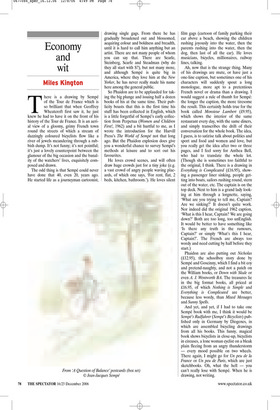Economy and wit
Miles Kington
There is a drawing by Semp├® of the Tour de France which is so brilliant that when Geoffrey Wheatcroft first saw it, he just knew he had to have it on the front of his history of the Tour de France. It is an aerial view of a gloomy, grimy French town round the streets of which a stream of dazzingly coloured bicyclists flow like a river of jewels meandering through a rubbish dump. ItŌĆÖs not funny; itŌĆÖs not pointful; itŌĆÖs just a lovely counterpoint between the glamour of the big occasion and the banality of the watchersŌĆÖ lives, exquisitely composed and drawn.
The odd thing is that Semp├® could never have done that 40, even 20, years ago. He started life as a journeyman cartoonist, drawing single gags. From there he has gradually broadened out and blossomed, acquiring colour and boldness and breadth, until it is hard to call him anything but an artist. There are not many people of whom you can say that. There are Searle, Steinberg, Scarfe and Steadman (why do they all start with S?), but not many more, and although Semp├® is quite big in America, where they love him at the New Yorker, he has never really made his name here among the general public.
So Phaidon are to be applauded for taking the big plunge and issuing half a dozen books of his at the same time. Their publicity boasts that this is the first time his stuff has been collected in English, which is a little forgetful of Semp├®ŌĆÖs early collection from Perpetua (Women and Children First!, 1962) and a bit hurtful to me, as I wrote the introduction for the Harvill PressŌĆÖs The World of Semp├® not that long ago. But the Phaidon explosion does give you a wonderful chance to survey Semp├®'s methods at leisure and to sort out his favourites.
He loves crowd scenes, and will often draw huge crowds just for a tiny joke (e.g. a vast crowd of angry people waving placards, of which one says, ŌĆśFor rent, flat, 2 beds, kitchen, bathroom.ŌĆÖ). He loves silent film gags (cartoon of family parking their car above a beach, showing the children rushing joyously into the water, then the parents rushing into the water, then the dog, then last of all the car). He loves musicians, bicycles, millionaires, railway lines, talking.
Ah, now that is the strange thing. Many of his drawings are mute, or have just a one-line caption, but sometimes one of his characters will suddenly spout a long monologue, more apt to a pretentious French novel or drama than a drawing. I would suggest a rule of thumb for Semp├®: the longer the caption, the more tiresome the result. This certainly holds true for the book called Monsieur Lambert (┬Ż9.95), which shows the interior of the same restaurant every day, with the same diners, and simply transcribes the drift of their conversation for the whole book. The idea, I guess, is to satirise talk about politics and sport and food and women and love, but you really get the idea after two or three pages, and I feel sorry for Anthea Bell, who had to translate the whole lot. (Though she is sometimes too faithful to the original, I think. There is a drawing in Everything is Complicated (┬Ż16.95), showing a passenger liner sinking, people getting into boats, sailors rushing round, stern out of the water, etc. The captain is on the top deck. Next to him is a grand lady looking at him through a lorgnette, saying, ŌĆśWhat are you trying to tell me, Captain? Are we sinking?ŌĆÖ It doesnŌĆÖt quite work. Nor indeed did the original 1962 caption, ŌĆśWhat is this I hear, Captain? We are going down?ŌĆÖ Both are too long, too unEnglish. It would be better to have something like ŌĆśIs there any truth in the rumours, Captain?ŌĆÖ or simply ŌĆśWhatŌĆÖs this I hear, Captain?ŌĆÖ. The French are always too wordy and need cutting by half before they start.) Phaidon are also putting out Nicholas (┬Ż12.95), the schoolboy story done by Semp├® and Goscinny, which I find a bit coy and pretend-naughty, and not a patch on the William books, or Down with Skule or even A. J. Wentworth BA. The treasures lie in the big format books, all priced at ┬Ż16.95, of which Nothing is Simple and Everything is Complicated are better, because less wordy, than Mixed Messages and Sunny Spells.
And yet, and yet, if I had to take one Semp├® book with me, I think it would be Semp├®ŌĆÖs Radfahrer (Semp├®ŌĆÖs Bicyclists) published only in Germany by Diogenes, in which are assembled bicycling drawings from all his books. This funny, magical book shows bicyclists in close-up, bicyclists in circuses, a lone woman cyclist on a bleak plain fleeing from an angry thunderstorm ŌĆö every mood possible on two wheels. There again, I might go for Un peu de la France or Un peu de Paris, which are just sketchbooks. Oh, what the hell ŌĆö you canŌĆÖt really lose with Semp├®. When he is drawing, not writing.






































































































































 Previous page
Previous page